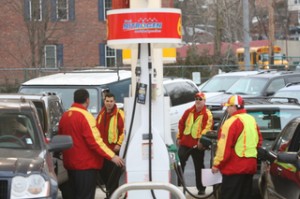As a new crisis looms in the Middle East where a Jihadist army has seized territory from the government of Iraq, oil prices – and ultimately the price of gasoline – are expected to move upwards, putting pressure on the consumers and automakers.
Oil prices have risen to the highest level this year over fears of the violence disrupting exports from Iraq, which is a leading member of the Organization of Petroleum Export Countries (OPEC) member.
While services such as GasBuddy.com haven’t reported any big movements in gasoline prices across the U.S., analysts are expecting gasoline prices to rise by as much as 10 cents per gallon. The fighting in Iraq also could spell the end of several months of stable gasoline prices, which have been a boon to automakers as sales of pickup trucks and utility vehicles have increased during the past 12 months.
A rebound in the housing market has helped fuel pickup trucks sales, but while housing starts were soft this past winter, the seasonally adjusted annual sales topped 16 million units in March, April and May, suggesting consumers had gotten used to stable gasoline prices, which had averaged $3.63 per gallon for the past year, according to Gas Buddy.
Earlier this month, however, AAA noted that one week into the summer driving season, the national average price for regular unleaded gasoline is $3.67 per gallon. The price was 1 cent less than last month but it is a penny more than last week and a nickel more than on the same date last year, AAA said.
“Entering the summer months, AAA expects that drivers will experience little relief at the pump and prices are likely to remain near a range of $3.55-$3.70 per gallon, which is similar to last summer’s range of $3.47-$3.67,” it reported.
However, “continuing geopolitical concerns, major refinery disruptions or a severe hurricane season could send the national average higher than anticipated,” in a report issued before the before the Jihadist capture of the Iraqi city of Mosul.
The intensity and duration of any increase in gasoline prices – and subsequent oil shock – could ultimately depend on OPEC’s ability to offset the loss of production from Iraq. OPEC could make more oil available on global markets. Russia and Iran, both of which are currently involved in diplomatic quarrels with the U.S., also could make more available.
(F1 champ Schumacher leaves hospital. For more, Click Here.)
In the last few years, the U.S. has been able to keep oil prices stable, albeit at a historically high levels, thanks to new recovery methods that have given new life to older wells in the U.S. and led to the discovery of new domestic reserves.
However, the U.S still depends on imports of crude from OPEC.
(Click Here for details about Alfa’s ambitious U.S. comeback.)
The last major shock to oil prices followed the disruption and destruction to domestic supplies created by Hurricane Katrina and other storms in the Gulf of Mexico in 2005.
The subsequent rise in gasoline prices led to slower sales of trucks and traditional sport utility vehicles, leaving all three domestic carmakers treading water as the scrambled to build more fuel-efficient vehicles. Ford took out a $23 billion loan a year after Hurricane Katrina and the profitability of Chrysler and General Motors effectively vanished, leaving the vulnerable to the financial upheaval that followed the collapse of Lehman Brothers in 2008.
(To see how the Canada’s election results could be good for U.S. automakers, Click Here.)
Ford, GM and Chrysler have all dramatically improved the fuel economy of their vehicles since the middle of the last decade but sales figures also show they are still dependent on sales of trucks and utility vehicles.
Chrysler recorded its 49 consecutive monthly sales increase even though sales of passenger cars tailed off thanks to robust sales of Jeep utility vehicles and Ram trucks. GM predicted a market share increase for the full year based on the continuing strength of its trucks and full-sized utility vehicles.


ANY excuse will do to raise the already outrageous crude oil prices higher. When there is an industry monopoloy you know it’s bad for society.